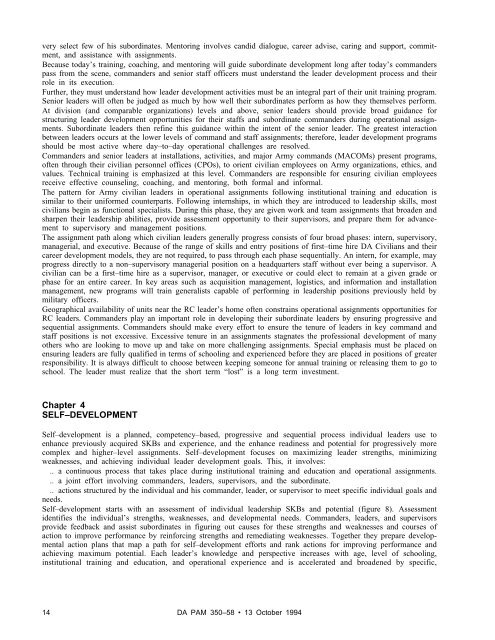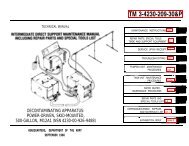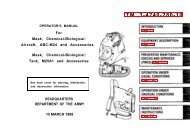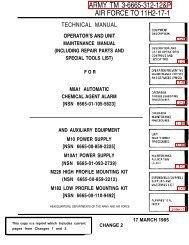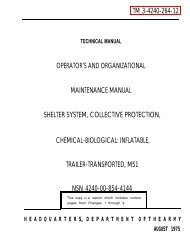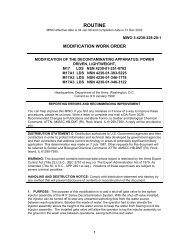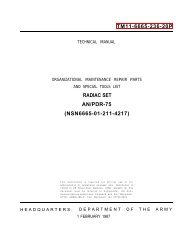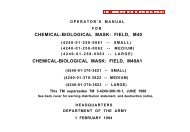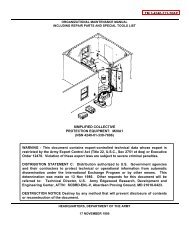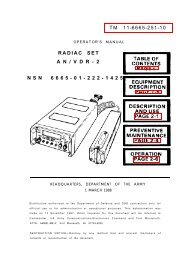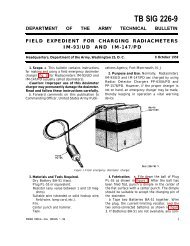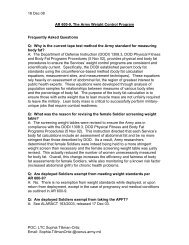LEADER DEVELOPMENT FOR AMERICA'S ARMY
LEADER DEVELOPMENT FOR AMERICA'S ARMY
LEADER DEVELOPMENT FOR AMERICA'S ARMY
You also want an ePaper? Increase the reach of your titles
YUMPU automatically turns print PDFs into web optimized ePapers that Google loves.
very select few of his subordinates. Mentoring involves candid dialogue, career advise, caring and support, commitment,<br />
and assistance with assignments.<br />
Because today’s training, coaching, and mentoring will guide subordinate development long after today’s commanders<br />
pass from the scene, commanders and senior staff officers must understand the leader development process and their<br />
role in its execution.<br />
Further, they must understand how leader development activities must be an integral part of their unit training program.<br />
Senior leaders will often be judged as much by how well their subordinates perform as how they themselves perform.<br />
At division (and comparable organizations) levels and above, senior leaders should provide broad guidance for<br />
structuring leader development opportunities for their staffs and subordinate commanders during operational assignments.<br />
Subordinate leaders then refine this guidance within the intent of the senior leader. The greatest interaction<br />
between leaders occurs at the lower levels of command and staff assignments; therefore, leader development programs<br />
should be most active where day–to–day operational challenges are resolved.<br />
Commanders and senior leaders at installations, activities, and major Army commands (MACOMs) present programs,<br />
often through their civilian personnel offices (CPOs), to orient civilian employees on Army organizations, ethics, and<br />
values. Technical training is emphasized at this level. Commanders are responsible for ensuring civilian employees<br />
receive effective counseling, coaching, and mentoring, both formal and informal.<br />
The pattern for Army civilian leaders in operational assignments following institutional training and education is<br />
similar to their uniformed counterparts. Following internships, in which they are introduced to leadership skills, most<br />
civilians begin as functional specialists. During this phase, they are given work and team assignments that broaden and<br />
sharpen their leadership abilities, provide assessment opportunity to their supervisors, and prepare them for advancement<br />
to supervisory and management positions.<br />
The assignment path along which civilian leaders generally progress consists of four broad phases: intern, supervisory,<br />
managerial, and executive. Because of the range of skills and entry positions of first–time hire DA Civilians and their<br />
career development models, they are not required, to pass through each phase sequentially. An intern, for example, may<br />
progress directly to a non–supervisory managerial position on a headquarters staff without ever being a supervisor. A<br />
civilian can be a first–time hire as a supervisor, manager, or executive or could elect to remain at a given grade or<br />
phase for an entire career. In key areas such as acquisition management, logistics, and information and installation<br />
management, new programs will train generalists capable of performing in leadership positions previously held by<br />
military officers.<br />
Geographical availability of units near the RC leader’s home often constrains operational assignments opportunities for<br />
RC leaders. Commanders play an important role in developing their subordinate leaders by ensuring progressive and<br />
sequential assignments. Commanders should make every effort to ensure the tenure of leaders in key command and<br />
staff positions is not excessive. Excessive tenure in an assignments stagnates the professional development of many<br />
others who are looking to move up and take on more challenging assignments. Special emphasis must be placed on<br />
ensuring leaders are fully qualified in terms of schooling and experienced before they are placed in positions of greater<br />
responsibility. It is always difficult to choose between keeping someone for annual training or releasing them to go to<br />
school. The leader must realize that the short term “lost” is a long term investment.<br />
Chapter 4<br />
SELF–<strong>DEVELOPMENT</strong><br />
Self–development is a planned, competency–based, progressive and sequential process individual leaders use to<br />
enhance previously acquired SKBs and experience, and the enhance readiness and potential for progressively more<br />
c o m p l e x a n d h i g h e r – l e v e l a s s i g n m e n t s . S e l f – d e v e l o p m e n t f o c u s e s o n m a x i m i z i n g l e a d e r s t r e n g t h s , m i n i m i z i n g<br />
weaknesses, and achieving individual leader development goals. This, it involves:<br />
.. a continuous process that takes place during institutional training and education and operational assignments.<br />
.. a joint effort involving commanders, leaders, supervisors, and the subordinate.<br />
.. actions structured by the individual and his commander, leader, or supervisor to meet specific individual goals and<br />
needs.<br />
Self–development starts with an assessment of individual leadership SKBs and potential (figure 8). Assessment<br />
identifies the individual’s strengths, weaknesses, and developmental needs. Commanders, leaders, and supervisors<br />
provide feedback and assist subordinates in figuring out causes for these strengths and weaknesses and courses of<br />
action to improve performance by reinforcing strengths and remediating weaknesses. Together they prepare developmental<br />
action plans that map a path for self–development efforts and rank actions for improving performance and<br />
achieving maximum potential. Each leader’s knowledge and perspective increases with age, level of schooling,<br />
i n s t i t u t i o n a l t r a i n i n g a n d e d u c a t i o n , a n d o p e r a t i o n a l e x p e r i e n c e a n d i s a c c e l e r a t e d a n d b r o a d e n e d b y s p e c i f i c ,<br />
14 DA PAM 350–58 • 13 October 1994


